| Georgia is a small country in the Caucasus, surrounded on the north by Russia, on the east by Azerbaijan, on the south by Armenia and Turkey and on the west by the Black Sea. Formerly the Georgian Soviet Socialist Republic (GSSR) of the Union of Soviet Socialist Republics (USSR), Georgia includes two autonomous republics—Abkhazia and Ajaria—and one autonomous region—South Ossetia. Georgia occupies a territory of 69.700 square km-s (about 26,900 sq mi). Georgia is a mountainous country. The Northern geographical boundaries run along the Great Caucasian Range, which includes the Main Caucasian Range, and its other chains stretch to the South. The Western part of the country is washed by the Black Sea. The population is approximately 4 million and is made up of nearly a hundred different ethnic groups. Georgians comprise the largest group with about 70 per cent of the population, followed by Armenians (9 per cent), Russians (7.4 per cent), and Azeris (5.1 per cent). Large numbers of Ossetians, Greeks and Abkhazians also reside in the republic. About 61 per cent of the population live in cities. Tbilisi is the capital and largest city with a population of 1,268,000 (1990 estimate). Tbilisi stands on the river Mtkvari and is surrounded by mountains.
Georgia is located on the crossroads of Europe and Asia and the Great Silk Road once passed through the country. It has a very important geo-political location connecting east to West. Famous Georgian writer Konstantine Gamsakhurdia said: “Georgia was in the center of the Bridge of Fate, which is called Caucasus. Thousands of nations, of thousands of origins and languages passed that bridge” (57, p.748); “Our territory was “a bridge of nations”. Our historical mission was to balance the two poles of confrontation and contrast, the blending of the spirit of two great worlds - Europe and of Asia. Our entire culture represents the light-and-shade contrasts of those worlds…Our historical role is that of a connector. We used to unite and connect the cultures of Persia, Asia Minor – to the culture of Old Greece and Byzantine, and provided it with our own, specific Georgian form and image. Firmly standing on our own grounds, we were fed by two breasts and our country became a uniting basin of two cultural streams” (59, p.147,148).
Georgian, a unique, non-Indo-European language, which belongs to Iberian-Caucasian family, is the country’s official language. 14 different alphabets exist in the world, one of which is Georgian. Georgians belong to Caucasus race (Caucasians). Some scholars propose the idea of possible links of the Ibero-Caucasian groups – and the peoples speaking those languages – with the peoples who created the pre-Hellenic (Pelazgues-Anatolian) culture.
The ancestral language, “super-language” spoken at least 15,000 years ago all over Europe and Asia can be traced down to the language spoken by people living in modern territory of Georgia – says Professor of Evolutionary Biology Mark Pagel from the University of Reading.
Those who know the myth about the Argonauts might remember that the leader of the Argonauts, Jason, traveled to Kolkhida across the Black (Euxine) Sea in search of the Golden Fleece finally finding his beloved Medea. In XIII century BC Kolkhida was the name of the land, which is now Western Georgia (with the capital Kutaisi). Whereas the Eastern part of Georgia in the XIII century BC was called Diaokhi or Tao, and later in VII-VI century BC it was called Iberia (with its ancient capital Mtskheta). So Colchis was described by Homer and Hesiod in connection with the famous legend of the Argonauts. The ancient Greek writers of the VI century BC give more accurate data on Colchis and Iberia, mentioning the silver coins, roads, bazaars and stores built for trade, the architecture of the houses, etc. 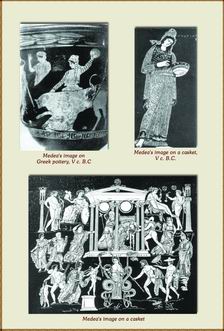 The fact is, that at the reign of Aiety (3300 or 3700 years ago), the Greeks considered Kolkhida a strong unit, which had a big fleet, had its written language, and generally, its own civilization, considerably developed. The country was famous because of its gold and metallurgy… The Argonauts made a voyage in search of the Golden Fleece that belonged to the great King Aiety of Colchis, son of Helios, god of the sun. In Greek mythology reference is made to the river Phasis (modern Rioni) and Kutaia the capital of Colchis (modern Kutaisi). King's wife Hecate had herb gardens in Phasis. This was in the 14th-13th cc. BC, i.e. 800-900 years before the time of Hippocrates. So in Georgia medical science and pharmacology were developed in ancient times. Archaeological findings testify to the high level of development of Medicine in Georgia. These data are confirmed by historical, mythological and literary courses, folklore and ancient Classical written documents. Kurt Sprengel, an outstanding German scholar, founder and systematizer of the history of world medicine, classes Colchis-Iberian medicine as foremost among the ancient medicines of the old civilization. Legend were created around the beauty and the wiles of Medea, the daughter of the Colchian king and a priestess of Hecate. Medea was famous as the beautiful "Great Magician", treating people with herbs and medicines. "Her name has become a basis for the science of medicine" as we read in the book of the famous Georgian scholar and researcher of the historical development of pharmacology in Georgia Sokrat Salukvadze. "It should be noted, that the word "medicus" denotes in Greek "a woman-physician", also "sage" - a typical designation of a medical man, savant... If we consider that one of the branches of modern medicine - venerology, was named after Venus, hygiene - after Hygieia, galenic - after Claudius Galenus, the the assumption that "medicine" originated from the proper name "Medea" would seem quite justified; this is also confirmed by mythological sources about Medea's preoccupation with medicinal plants and healing. The author maintains that Medea is not a merely a character from Greek mythology, but a historical character. Evidence on Colchian-Iberian medicine is one of the oldest in the world". So Georgia is a homeland of medicine (Medea-medicine). Characteristically, K. Sprengel noted that "all medicinal manipulations, the knowledge and appreciation of medicinal herbs, the technological process of preparations of poisons, etc., were all linked to the name of Medea and are known in history of medicine as "Cura Mediana". Medea was greatly respected. Songs were written and temples were built in her honor in ancient Greece. The fact is, that at the reign of Aiety (3300 or 3700 years ago), the Greeks considered Kolkhida a strong unit, which had a big fleet, had its written language, and generally, its own civilization, considerably developed. The country was famous because of its gold and metallurgy… The Argonauts made a voyage in search of the Golden Fleece that belonged to the great King Aiety of Colchis, son of Helios, god of the sun. In Greek mythology reference is made to the river Phasis (modern Rioni) and Kutaia the capital of Colchis (modern Kutaisi). King's wife Hecate had herb gardens in Phasis. This was in the 14th-13th cc. BC, i.e. 800-900 years before the time of Hippocrates. So in Georgia medical science and pharmacology were developed in ancient times. Archaeological findings testify to the high level of development of Medicine in Georgia. These data are confirmed by historical, mythological and literary courses, folklore and ancient Classical written documents. Kurt Sprengel, an outstanding German scholar, founder and systematizer of the history of world medicine, classes Colchis-Iberian medicine as foremost among the ancient medicines of the old civilization. Legend were created around the beauty and the wiles of Medea, the daughter of the Colchian king and a priestess of Hecate. Medea was famous as the beautiful "Great Magician", treating people with herbs and medicines. "Her name has become a basis for the science of medicine" as we read in the book of the famous Georgian scholar and researcher of the historical development of pharmacology in Georgia Sokrat Salukvadze. "It should be noted, that the word "medicus" denotes in Greek "a woman-physician", also "sage" - a typical designation of a medical man, savant... If we consider that one of the branches of modern medicine - venerology, was named after Venus, hygiene - after Hygieia, galenic - after Claudius Galenus, the the assumption that "medicine" originated from the proper name "Medea" would seem quite justified; this is also confirmed by mythological sources about Medea's preoccupation with medicinal plants and healing. The author maintains that Medea is not a merely a character from Greek mythology, but a historical character. Evidence on Colchian-Iberian medicine is one of the oldest in the world". So Georgia is a homeland of medicine (Medea-medicine). Characteristically, K. Sprengel noted that "all medicinal manipulations, the knowledge and appreciation of medicinal herbs, the technological process of preparations of poisons, etc., were all linked to the name of Medea and are known in history of medicine as "Cura Mediana". Medea was greatly respected. Songs were written and temples were built in her honor in ancient Greece.
The concept of the Golden Fleece is thought by some scholars to derive from the ancient practice of panning for gold in the streams of the Caucasus Mountains, using sheep fleeces to catch grains of gold and then hanging them from trees to dry. It is also interesting that ancient Greek sources contain numerous allusions that the treasure Colchis preserved was not the Golden Fleece (it is a figment of poetic imagination), but a parchment book describing a method of obtaining gold. 33 centuries later, in 1984, Timothy Severin, the Irish traveler, geographer and writer and courageous explorer of antiquity, retraced the trip of the brave Argonauts and with this he confirmed the reality of myth.
Do you know how the Georgians call themselves? 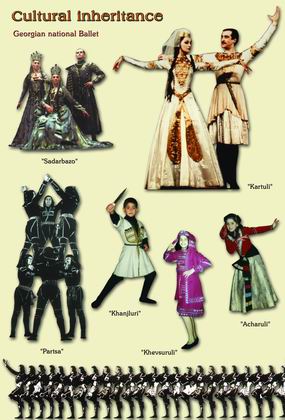
The Georgians call themselves "kartvelebi" and their country "Sakartvelo". The Georgians trace their origins to Noah's great-grandson Karthlos. The foreign name Georgia, used throughout Western Europe, is mistakenly believed to come from the country's patron saint, St. George. Indeed, the very name "Georgia" is not part of the language at all; we owe it to the Romans who applied a Latin word for "farming" to the region, presumably in reference to its rich and well-worked soil. The Romans called Georgia Iberia and the people Iberians; Ancient Greeks called the country "Georgica" (which means "country of agriculture or tillage") and the people "Georgians" (tillers) (because when the Greeks came to Georgia they saw the Georgians working on the land); Russians call the country "Gruzia" and the people "Gruzini"; Turks call the country "Gurjistan" and the people - "Gurdji".
A few words should be said about the name the Georgians identify themselves with. The Georgians call themselves "Kartveli". This name goes back to the designation of the central part of East Georgia, Kartli; hence, the common term all Georgians identify themselves with: Kartveli, i.e. an inhabitant of Kartli. Later on, this common designation served as the basis for the name of the whole country: "Sakartvelo" i.e. "the land in which the Kartvelians (Georgians) live". Hence, "Kartuli ena", i.e. the Georgian or the Kartvelian language; accordingly, the study of Georgia and everything connected with it is called "Kartvelology".
Yes, there is an Iberian Peninsula. It may not be simply coincidence that the far western fringe of the Roman world was called by the same name as the far eastern fringe - Iberia - especially as we may understand them both to be connected by the River of Ocean flowing below and abound the earth. One of the hypotheses highly speculated by the scholars stated that the Iberians were the tribes which migrated from the South Caucasus towards the West where some reached the Iberian Peninsula, and some of them went as far north as the British Isles. There are some linguistic similarities between the Georgian and Basque languages, there are some toponims also resembling each other as well as similar words and similar traditions in both regions. According to the opinion of several scientists, the Caucasians (Kartvelians among them) – together with Basques, and Pelazgues and Etruscans (extinct in ancient period), might be possible remains of the great ethnic family living on the vast territories at the Mediterranean and in Asia Minor, before the people of the Indo-European group made the area the place of their habitat. It should also be noted, that some of the famed researchers (Humboldt, Beaudrimon, Filiponi, Marr and others), consider the Basques (descendants of the non-Romanized European Ibers) living in Spain, to be the people who migrated to the West, and this is equal to the acknowledgement of ethnic relations between Kartvelians and Basques, and regarding the formers as the autochthons of the Caucasus. The linguistic studies of a Polish linguist, I. Braun, present the Basques as the descendants of the fourth major tribe of the Kartveluri origin.
Apparently, this ethno-genetic theory was also well known in ancient Georgia and their firm belief was of the kinship and relations of the Pyrenean Ibers to the Georgians, thus favoring the concept of the blood relations and closeness. This is supported by the fact, that the terms “Ibers of Spain” and “Celt-Ibers”, used by Greek authors, are presented in old Georgian writings such as “the Kartvels of the West” and “Celt-Kartvels”; very important appears the note of Giorgi Mtatsmindeli (XI c.) about the wish of the Georgian nobility to travel to Spain and visit the local “Georgians of the West”; Jean Chardin (XVII c.) writes in records, as if he was asked by a Georgian king – before his departure: “how is my relative, King of Spain?” and then drank his toast from a goblet covered with gems. The views regarding the genetic closeness of Ibers of Caucasia and Pyrenees is worth considering because a lot of archaeological, historical, linguistic and ethnographic data, the theory concerning the Basque and the Caucasus, are still considered as one of the most pressing questions of modern period.
It can be said that the history of Georgia goes back to the dawn of time. In 1991-99 the relics of the first human migration were found in the Dmanisi area situated south of Tbilisi. The relics of Dmanisi Hominids - Homo erectus georgicus are around 1 million 800 thousand years old and are not only the oldest in Europe but anywhere outside Africa.
The history of Georgia is over 3000 years old. It is one of the most ancient countries of the world. The legend of Amirani (the Georgian Prometheus) is a story of a man who stole fire from the gods, gave it to the people and taught them metal working. The god punished Amirani by chaining him to the Caucasus mountains. The people of Georgia were amongst the first in the Caucasus to master the smelting and casting of metals, first copper and bronze, then, as early as the 9th-7th centuries B.C., iron. Archeological excavations provide clear evidence that Georgian tribes formed their statehood as early as the 10-th 8-th centuries BC. The archeological material from Trialeti, Akhalgori, Vani, the north-east littoral of the Black Sea and elsewhere, as well as foreign sources confirm that before the 1-st millennium BC Kartvelian (Georgian) tribes had already mastered the skill of smelting iron, had highly developed advanced manufacturing processes for various ceramic wares. 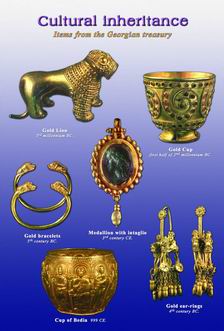 Among these people were accomplished goldsmiths and talented builders. Among these people were accomplished goldsmiths and talented builders.
The Georgian tribes of West and East were united under King Parnavaz in the IV-III centuries BC. So King Parnavaz is the first king of the united Georgia. Georgian is one of the oldest living languages in the world. Georgian script, which is unique among the 14 known in the world, also dates from this period. According to Leonti Mroveli, an 11th century historian, the credit for introducing the Georgian alphabet and the establishment of the Georgian language of the realm goes to King Parnavaz. "He disseminated the Georgian language far and wide and no other tongue was thenceforth used other than Georgian: he also created the Georgian writing", says the chronicle. On the strength of this evidence we can conclude that Georgian became the state language of the kingdom under Parnavaz. According to the eminent linguistic A. Chikobava, "the deeper we go back into the past of the Kartvelian and Ibero-Caucasian languages, the better we can feel their genetic connection with those of the ancient civilizations of Nearer Asia and Mesopotamia (Urartu, Hurian, Hittite, Elamite and Sumerian)". The first finding of Georgian script date to the VI century BC. The first finding of Georgian book date to the V century AD (Martyrdom of Shushanik"). The book is written in old Georgian Asomtavruli script. The refined language and the high artistic level of this brilliant composition suggest that it could not have been the first of it's kind, and that the Georgian people must have had a well-developed literature centuries before Christ; the literature is believed to have been destroyed by the Christian Church.
Georgia has been an ancient Christian country. Georgia is called "allotted portion of Mother of God" (when the Apostles cast lots for the clarification to which country each of the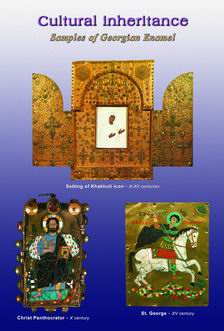 m was going to preach, The Most Holy Mother of God was allotted to go and preach to Georgia). By God’s will the Mother of God stayed in Jerusalem while St. Andrew the First-called went to preach to Georgia with the Holy Mother’s Icon (not made by humans hands). Three apostles of Christ: St. Andrew the First-called, St. Simon the Canaanite and St. Matthata preached the Gospel in Georgia (St. Simon the Canaanite is buried near Sokhumi, in the village of Comani, St. Matthata preached in the Southwest of Georgia and was buried in Gonio, a village not far from Batumi). That's why the Orthodox Church of Georgia is called "Apostolic". Christianity was declared the official state religion in 325 AD. This fact is connected with the names "Equal to the Apostles" of St. Nino, King Mirian and Queen Nana. Georgia is rich with churches and monasteries. Georgian culture - both old and modern - is essentially Christian. For centuries the fight for freedom was identified as the fight for the defense of Christianity. Christianity has enabled Georgians to preserve their statehood, language and culture throughout the centuries. m was going to preach, The Most Holy Mother of God was allotted to go and preach to Georgia). By God’s will the Mother of God stayed in Jerusalem while St. Andrew the First-called went to preach to Georgia with the Holy Mother’s Icon (not made by humans hands). Three apostles of Christ: St. Andrew the First-called, St. Simon the Canaanite and St. Matthata preached the Gospel in Georgia (St. Simon the Canaanite is buried near Sokhumi, in the village of Comani, St. Matthata preached in the Southwest of Georgia and was buried in Gonio, a village not far from Batumi). That's why the Orthodox Church of Georgia is called "Apostolic". Christianity was declared the official state religion in 325 AD. This fact is connected with the names "Equal to the Apostles" of St. Nino, King Mirian and Queen Nana. Georgia is rich with churches and monasteries. Georgian culture - both old and modern - is essentially Christian. For centuries the fight for freedom was identified as the fight for the defense of Christianity. Christianity has enabled Georgians to preserve their statehood, language and culture throughout the centuries.
Georgians have fought against numerous invaders from almost all known empires of the world. So the history of Georgia is a history of fight for freedom. The incursions by Romans, Greeks, Arabs, Byzantines, Mongols, Turks, Persians, Russians and the tribes of the region of North Caucasus often led to the destruction of Georgia. The traces of these wars are still noticeable. These are ancient towers, fortresses and towns in caves. “The history of Georgia is the story of the severe deficiency of peace needed for the normal development of any nation, the story of endless wars, unhappiness and heroic endurance and great restoration – in order to preserve their land, their language, and their religion". As Ilia Chavchavadze said, “Georgia was armed day and night, with enemies attacking from all sides… A handful of people had to do their utmost, with arms in their hands, in order to defend their country from destruction”. For example, Tbilisi was forty times destroyed by the enemies and forty times it rose from its ruins and ashes like the Phoenix. In the year of 65 BC Pompey the Great conquered the Georgia. Among the casualties Roman soldiers found armed women and were amazed, so the rumors were spread in Rome that Pompey in the east fought not only with men, but with the Amazons (beautiful warlike women). After that Rome chose a policy of friendship and alliance with old Iberia. The Emperor Antonius Pius allied himself with King Parsman II of Iberia and even erected an equestrian statue of the Iberian King on the field of Mars (same Campus Martius) in Rome. Cassius Dio immortalized such an episode dated to the early years of the reign of Antonius Pius (138-161): „When Pharasmanes the Iberian came to Rome with his wife, Antonius increased his domain, allowed him to offer sacrifice on the capital, set up an equestrian statue in the temple of Bellona and viewed an exercise in arms in which this chieftain, his son, and the other prominent Iberians took place“ (LXIX, 15, 3). In about the 500s BC, western Georgia was colonized by Ionian Greeks. Then in the 5th century AD the region was conquered by the Persians, then by Byzantines. In the 7-9th centuries Georgia was conquered by Arabs and then in the 11th century by the Seljuk-Turks. King David IV (1089-1125), called "David the Builder" for his creative political activity, expelled the Turks in the early 12th century, reuniting Georgia as a kingdom. Sultan Mahmud of Iran gathered enormous funds for a campaign against King David. In 12 August, 1121 there was a decisive "Didgoris" battle, where King David the Builder along with Armenian, Kipchag, Ossetian and Shirvan allies - all together 56 000 faithful soldiers - defeated Turk-Seljuk's 300 000 army. The resulting victory is known and celebrated by Georgians as "dzleva sakvirveli" (the wonderful victory). During the Crusades, King David the Builder is said to have had contact with Baldwin, King of Jerusalem, and two hundred Crusaders are said to have been part of David's forces at the Battle of Didgori, where he inflicted a crushing defeat on the Seljuks in 1121. After that victory over Turk-Seljuks, Georgia underwent a process of unprecedented revival, and within the period of the end of XII century and the beginning of the XIII century it developed into the most powerful state in the whole Asia Minor (with the capital in Tbilisi), which incorporated almost the entire Caucasus and adjoining regions and was spread “from Nikopsia to Daruband" between the Black and Caspian seas. United Georgia became a powerful political force that controlled the entirety of Transcaucasia and adjacent regions, the important trade routs passing through it connecting Oriental countries with Byzantium and tribes north of the Caucasus with Iran and the Middle East. Under King David The Builder a regular army was set up, as well as academies of Gelati and Ikalto. King David the Builder, a most endowed figure at the time, turned Gelati Academy into the largest and most authoritative centre of enlightenment and education in the whole of the Middle East. He invited to this Academy the most renowned scholars and cultural activists from Georgia and from abroad. The Golden Age of Georgia is connected with the reign of the Queen Tamar (1184-1213), (though Georgians always called her "King-woman Tamar"). 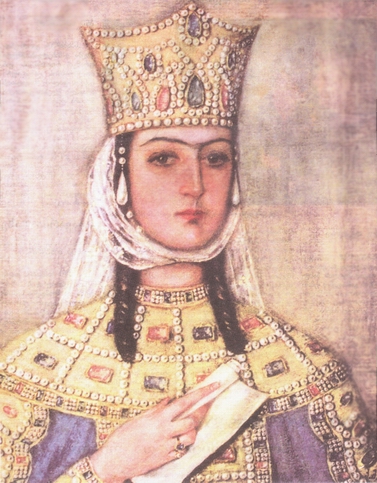 She was the only daughter of the King Giorgi III, grandson of the King David the Builder. The king was afraid that feudal lords would be against of a woman's accession to the throne, so he crowned his daughter Tamar while he was alive. During King-Woman Tamar's reign Georgians won two decisive battles with Turks (Shamkori and Basiani battles). Shota Rustaveli's immortal poem "The Knight in the Panther's Skin" is dedicated to the beautiful Queen Tamar. The poem is a masterpiece of Georgian literature of 12th century, which is the first place characterized by a tendency to raise the woman to social equality with the man. It was especially significant at a time when in the neighbouring Moslem world and even in Western Europe the woman was regarded as "an evil force" and her participation in the cultural life and statesmanship was inconceivable. A type of parliament came into existence. In Georgian this is called "darbazi". So Queen Tamar's period is known as the Georgian Renaissance, a period of great creative upsurge in Georgian agriculture, painting, goldsmith's skills, art, music, theatre, architecture, philosophy, literature, science, etc... But the “Golden Age” of the Georgian state proved to be short, because – starting from the XIII-XIV centuries, horrible succession of invasions of Khorezmians, Tatar Mongols and hordes of Tamerlane, eventually weakened the country. In the 13th century the Georgian kingdom was crushed by Mongol invaders. For centuries the Mongols ravaged the country. Towns and villages became abandoned by the population who fled to the mountains. Mongolian invasions significantly weakened the Georgian state. Following the decline and fall of the Byzantine Empire in the XV century, under the conditions of thorough changes of the geopolitical situation and the whole system of the world relationships, Georgia appeared encircled by an aggressive Muslim environment encirclement. Georgian Monarchs sought help from Western European countries and the Pope, but they were preoccupied with crusades and unable to assist. Then at the beginning of 15th century Tamerlane’s hordes invaded Georgia eight times, destroying Tbilisi twice. In the course of the 17th century, Georgia suffered from ruinous inroads of Shah Abbas's Persian hordes. This blood-thirsty conquerer killed over 100 000 in Kakheti region alone and another 200 000 he captured, moved them to Iran and made them settle there (nowadays offspring of those Georgians in remote village of Phereidan in Iran even after 400 years still preserve their mother-tongue, Georgian language). Turks virtually hunted young boys and girls to capture and sell them into slavery at Turkish slave markets. Thereafter, Georgia was under the control of Iran and the Ottoman Empire until the 18th century. So, many times Georgia became a battlefield between the great empires and faced the threat of a physical extermination. Georgia was geographically isolated from Western Europe and the Christian world as a whole. She was the only daughter of the King Giorgi III, grandson of the King David the Builder. The king was afraid that feudal lords would be against of a woman's accession to the throne, so he crowned his daughter Tamar while he was alive. During King-Woman Tamar's reign Georgians won two decisive battles with Turks (Shamkori and Basiani battles). Shota Rustaveli's immortal poem "The Knight in the Panther's Skin" is dedicated to the beautiful Queen Tamar. The poem is a masterpiece of Georgian literature of 12th century, which is the first place characterized by a tendency to raise the woman to social equality with the man. It was especially significant at a time when in the neighbouring Moslem world and even in Western Europe the woman was regarded as "an evil force" and her participation in the cultural life and statesmanship was inconceivable. A type of parliament came into existence. In Georgian this is called "darbazi". So Queen Tamar's period is known as the Georgian Renaissance, a period of great creative upsurge in Georgian agriculture, painting, goldsmith's skills, art, music, theatre, architecture, philosophy, literature, science, etc... But the “Golden Age” of the Georgian state proved to be short, because – starting from the XIII-XIV centuries, horrible succession of invasions of Khorezmians, Tatar Mongols and hordes of Tamerlane, eventually weakened the country. In the 13th century the Georgian kingdom was crushed by Mongol invaders. For centuries the Mongols ravaged the country. Towns and villages became abandoned by the population who fled to the mountains. Mongolian invasions significantly weakened the Georgian state. Following the decline and fall of the Byzantine Empire in the XV century, under the conditions of thorough changes of the geopolitical situation and the whole system of the world relationships, Georgia appeared encircled by an aggressive Muslim environment encirclement. Georgian Monarchs sought help from Western European countries and the Pope, but they were preoccupied with crusades and unable to assist. Then at the beginning of 15th century Tamerlane’s hordes invaded Georgia eight times, destroying Tbilisi twice. In the course of the 17th century, Georgia suffered from ruinous inroads of Shah Abbas's Persian hordes. This blood-thirsty conquerer killed over 100 000 in Kakheti region alone and another 200 000 he captured, moved them to Iran and made them settle there (nowadays offspring of those Georgians in remote village of Phereidan in Iran even after 400 years still preserve their mother-tongue, Georgian language). Turks virtually hunted young boys and girls to capture and sell them into slavery at Turkish slave markets. Thereafter, Georgia was under the control of Iran and the Ottoman Empire until the 18th century. So, many times Georgia became a battlefield between the great empires and faced the threat of a physical extermination. Georgia was geographically isolated from Western Europe and the Christian world as a whole.
In order to rescue the country surrounded by Muslim states, Georgian King Erekle II tried to establish diplomatic relations with Orthodox Russia. In 1783 the co-called Georgievsk Treaty or "friendly-ally" treaty was concluded between Russia and Georgia. Under the treaty, Russia undertook to assist Georgia against all outside enemies. The "friendship" lasted for four years. Then in 1787 the two Russian battalions under the control of the Erekle II were withdrawn and the Georgian-Muslim relations became tense and complicated. On September 11, 1795, the Persian Governor Agha Muhammad Khan approached the borders of Tbilisi. The Georgians lost the battle and the country was ravaged by relentless eunuch conqueror Agha Mohammad Khan, who razed Tbilisi almost to the ground. "And came Agha Mohammad Khan into Tbilisi... burnt down chambers and royal palaces and all Tbilisi..." (Ioane Kartvelishvili, 19th century). The city was reduced to rubble. There were only two streets where people could walk and just one gate remained of the royal palace. Only the Mtkvari river flowed as before.
Russia obtained control of the state’s foreign affairs. In 1801, Alexander I, Tsar of Russia violated the Treaty, included Georgia in its empire and abolished the Georgian Kingdom. He issued a manifest announcing the liquidation of the kingdom of Kartli and Kakheti "and the whole nobility was gathered in Sioni Cathedral to swear an oath together with priests... the walls of Sioni were surrounded by the Russian army with canons, and those gathered were informed: unless you swear an oath of loyalty to Russia, you will be slain, and terrified Georgians began swearing the oath of allegiance and promised their obedience..." (Bagrat Bagrationi, 19th century). In 1801 the last Georgian king abdicated, and Georgia became a distant province of the Russian Empire. Members of the Bagrationi royal house were deprived of their property and were exiled to Russia. Russian was adopted as the official language. The Autocephaly of the Georgian Orthodox Church was annulled in 1811 and the Georgian Catholicos-Patriarch was replaced by Russian exarch. Tbilisi became the residence of the highest representative of the Russian authorities in Georgia - the Commander-in-Chief. From 1840 the city became the centre of the South Caucasus and later, from 1846, the residence of the Viceroy in the Caucasus. Thus, “the orientation on Russia to Georgians brought the loss of freedom and the establishment of another colonial system – this time under the rule of fellow-Christians”. Not long thereafter, an independence movement started in Georgia. The Georgian people rose against the Russian autocracy. True, during the period of the “Russian pressure”, the Georgians did not fall prey to the wild form of the previous persecution for their religion, but on the other hand, first time in their history, they had to live in the conditions of the total loss of the elements of state sovereignty and monarchique traditions. Certainly, this way of life was unbearable and disgraceful for Georgians, causing anti-Russian rebellions (1804, 1810, 1812, etc.).
The political forces of Georgia took advantage of the chaos in Russia caused by the Bolshevik overturn of the government in 1917 and on 26 May, 1918 "the Act of Independence of Georgia" was adopted at a session of the National Council in the Palace of Viceroy and Georgia was declared a sovereign "Democratic Republic of Georgia". This declaration was acknowledged by the Russian Soviet republic in concluding a peace agreement with Georgia on May 7, 1920. The life of the independent republic lasted for only two years and nine months before Georgia was once again subjugated by Russia. Some Bolshevik Georgians in Russia, who were faithful followers of Lenin: Joseph Jugashvili (Stalin) and Sego Orjonikidze could not tolerate with the "Menshevik" independence of Georgia. And in February 25 of 1921 Georgia was occupied by the eleventh Bolshevik Army and declared a Soviet Socialist Republic. Lenin's negotiations with Turkey regarding boundaries coincided with the Bolshevik's anti-Georgian policy, and so Georgia was deprived of parts of what had been long been its historical territory. The Russia and Turkey signed special treaty, according to which huge part of Southern Georgia Tao-klarjeti along with its Georgian population was given to Turkey and some parts to Azerbaijan. So independent for three years (1918-1921) following the Russian revolution, it was forcibly incorporated into the USSR until the Soviet Union dissolved in 1991. Even after the forced integration into the USSR, Georgians managed to preserve their national identity and never complied to subjugation.
A well-known Soviet dictator Ioseb Stalin (The Man of Steel) and the "Head" of his police Lavrenti Beria, both Georgians by origin, destroyed the hope of Georgians to win a national independence. In 1924 national-liberation rebellion was repressed and thousands of people were shot in a railway carriages. There were severe repressions in 1936-37. The repressions went on after Stalin’s death: in 9 March of 1956 his successor Nikita Khrushov severely suppressed a revolutionary attempt by means of Soviet tanks in Tbilisi, which was followed by deaths of hundreds of people. During Brezhnev governance in 1978 the Soviet officials wanted to abolish the Georgian and declare the Russian as the state language. This Russian Chauvinistic attempt was opposed by all nation with protest demonstrations which started at State University (mostly students) and finally Georgian language was declared a State language. Then Russian Soviet government found another way against Georgians (their motto was "Georgia without Georgians): in Abkhazia, Adjara and Samachablo (same South Ossetia) they started to incite separatist movement.
In present Georgian history 1989 year was a crucial moment, when in 9 April the Soviet Army (with the commander General Rodionov) broke up a peaceful demonstration. This resulted in a murder of 20 people (mostly women). It provoked public outrage and the society strongly supported the policy of a complete independence and a separation from the Soviet Union. The leader of the national-liberation movement Zviad Gamsakhurdia’s victory in elections of 26th May, 1990 was a direct result of it (he was elected president by more than 85% of the votes cast). Georgia became only the second republic, after Lithuania, to declare its sovereignty in 9 April of 1990. Internationally recognized independent state since 9 April 1991. But some Russian politicians dreamed of restoring Russian influence in the "near abroad" and reminisced about happy holidays in dachas on the Georgia's Black Sea coast.
In 1989 - Russia secretly encourage demands for more autonomy in the South Ossetia region which lead to violent clashes between Georgians and separatist Ossetians; a ceasefire agreement is signed in 1992 and Russian peacekeepers are deployed.
Relations with Russia have been tense since independence. Georgia borders Chechnya to the North, and the Chechen rebels and refugees have crossed into Georgia seeking refuge from Russian offensives. During the 1990's, tens of thousands of Chechen civilians fled across the border into Georgia's Pankisi Gorge.
1991-92 civil war in Georgia.
In 1992 January - Gamsakhurdia is deposed after fighting in central Tbilisi between government troops and opposition militias (Shevardnadze's followers). A Military Council was formed, which eventually turned power over to a State Council.
In 1992 March, Eduard Shevardnadze, former foreign minister of the Soviet Union under Gorbachev, was appointed head of the newly formed State Council and later became president.
In August 1992 - fighting breaks out in the Abkhazia region between Georgian government troops and separatist forces (incited by Russians). The Abkhaz Supreme Soviet declared Abkhazian independence in July 1992. Georgian authorities sent troops into Abkhazia ostensibly to protect supply routes and pursue forces loyal to Gamsakhurdia. Heavy fighting soon broke out, with the Abkhazian side receiving support from Russian "kazaks" and Caucasian peoples of similar ethnic background in Russia. Georgian forces lost considerable ground until a ceasefire agreement was reached in July 1993. The Abkhazians violated the agreement and started ethnic cleaning and expelled about 300,000 Georgians refugees by October 1993. In a 13-month war 10,000 people were dead. A large Western aid program was mounted to look after the refugees and many now live in an extreme poverty in Tbilisi.
In 1995 November - Shevardnadze wins elections to the restored post of president.
In 2000 April - Shevardnadze re-elected president.
Since 1989, one million people have emigrated. Under Shevardnadze's rule, country has lost control of a huge swath of land, including Abkhazia and South Ossetia and it has fallen into a morass of poverty, corruption and crime. The gross domestic product has shrunk by two thirds and expenditures double receipts. Up to 80 percent of the economy was illicit.
2002 April/May - US special forces arrive to train and equip Georgian forces for counterterrorist operations.
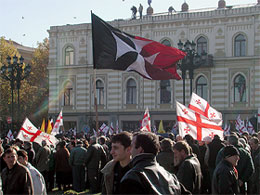 Protests against Mr. Shevardnadze came to a head following parliamentary elections on 2 November 2003. The elections – which handed victory to Shevardnadze’s supporters – were widely seen as rigged. Protests against Mr. Shevardnadze came to a head following parliamentary elections on 2 November 2003. The elections – which handed victory to Shevardnadze’s supporters – were widely seen as rigged. 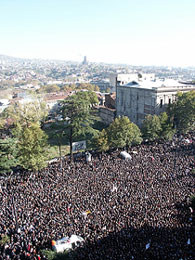 International observers allege numerous voting irregularities in parliamentary elections. This, coupled with years of corruption, economic collapse and unresolved conflicts with separatist regions pushed people into the streets of the capital Tbilisi, where massive protests finally forced Shevardnadze from power at the end of November. Thousands of protesters in Georgia's capital Tbilisi, have vowed not to leave until President Eduard Shevardnadze resigns. "The Rose Revolution" (or "velvet revolution"), as it is called, was achieved without the bloodshed that many had feared and led to presidential elections in early January that Saakashvili won with 96% of the vote. Georgia is now heralded as a model of peaceful popular sovereignty and as a democratic model for other former Soviet republics. International observers allege numerous voting irregularities in parliamentary elections. This, coupled with years of corruption, economic collapse and unresolved conflicts with separatist regions pushed people into the streets of the capital Tbilisi, where massive protests finally forced Shevardnadze from power at the end of November. Thousands of protesters in Georgia's capital Tbilisi, have vowed not to leave until President Eduard Shevardnadze resigns. "The Rose Revolution" (or "velvet revolution"), as it is called, was achieved without the bloodshed that many had feared and led to presidential elections in early January that Saakashvili won with 96% of the vote. Georgia is now heralded as a model of peaceful popular sovereignty and as a democratic model for other former Soviet republics.
On 25 January 2004 the new president of Georgia, Mikheil Saakashvili, was sworn in. Mr. Saakashvili, 36, now Europe's youngest 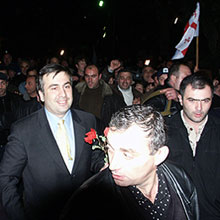 head of state, promised to drag the former Soviet republic out of a mire of poverty and corruption, while treading a fine diplomatic line between the United States, its key financier, and Russia, its old master. He has accused Moscow of aiding Abkhazia and South Ossetia, both historical provinces of Georgia in bitter wars that won them de facto independence from Tbilisi a decade ago, and has demanded that Russia fulfill a 1999 promise to close two military bases on Georgian territory. "Our course is European integration," he said. "And we are thankful for and appreciate the help that the US has provided us for years, and we will pass on that appreciation to our children. But we do not need Russia as an enemy. We need Russia as a friend. I want to extend the hand of friendship to Russia." head of state, promised to drag the former Soviet republic out of a mire of poverty and corruption, while treading a fine diplomatic line between the United States, its key financier, and Russia, its old master. He has accused Moscow of aiding Abkhazia and South Ossetia, both historical provinces of Georgia in bitter wars that won them de facto independence from Tbilisi a decade ago, and has demanded that Russia fulfill a 1999 promise to close two military bases on Georgian territory. "Our course is European integration," he said. "And we are thankful for and appreciate the help that the US has provided us for years, and we will pass on that appreciation to our children. But we do not need Russia as an enemy. We need Russia as a friend. I want to extend the hand of friendship to Russia."
After parliamentary elections of 2012 the billionaire businessman Bidzina Ivanishvili was confiremd as Prime Minister of Georgia. He is the leader of the coalition called "Georgian Dream".
-----------------------------------------------------------------------------------------------------------------------
The country is divided into 12 large administrative regions that are subdivided into 63 districts. Eight zones are under the control of city councils.
It can be definitely said about Georgia, that it is the country of ancient and great traditions in agriculture and farming, which is seen in its name, originated from the Greek word, expressing the idea of farming and labour on the earth and land. On that basis, Vakhushti presumes that “Sakartvelo was called Georgia due to the hard work of the Georgians (since “Giorgi” is translated as “labourer”). Before him, a Frenchman, De Troillo, also explained that the “Georgians received that name because of their agricultural skills and activities”.
Georgia's main economic activities include the cultivation of agricultural products such as citrus fruits, tea, hazelnuts, and grapes; mining of manganese, gold and copper; and output of a small industrial sector producing alcoholic and nonalcoholic beverages, metals, machinery, and chemicals. Ancient Georgia was the original homeland of various species of grapes and cereals. It should be noted that out of existing 27 species of wheat existing in the world now, the major part – 14 species are found in Georgia (and 6 among them are endemic), and here are preserved the ancient, initial (pale relict) forms, and on this basis our country is considered the first genocentre of the many species of the wheat. A large number of the researchers consider Georgia one of the ancient places the viticulture originated in and then spread in the world. The fact is that the rules of growing and caring for vines, were known on the territory of this country – the classical country of viticulture and wine-making, as early as 3300-3200 B.C. A archaeological findings show that at the end of the II millennium, wine-growing in Georgia was substantially advanced. Among the 4000 sorts of vines, registered in the world, 500 are Georgian sorts.
Georgia is divided into two historical and geographical regions: highlands and lowlands. The basic activity of highlanders was cattle-breeding, and for people living in the valleys, the lowlanders – farming.
Georgia is known for the abundance and variety of mineral waters and is one of the leading countries in this respect. There are more than 500 popular mineral waters such as Borjomi, Sairme, Nabeglavi, Zvare, Java, Kugela, etc. The territory of Georgia is rich in deposits and occurrences of mineral resources (oil, coal, iron ore, manganum, copper, lead and zink ore, mercury, antimony, non-ore minerals- agate deposits and quartz field spar sands). Andesite, barytes, bentonite clay, diatomite, talc and serpentine are also available. Georgia is also rich in valuable materials used for facing (basalt, granite, lime stone, marble, etc.).
|